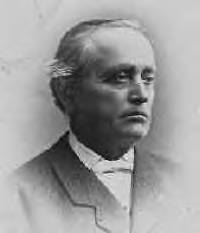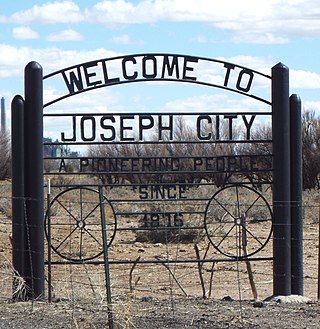
Santa Clara is a city in Washington County, Utah, United States and is a part of the St. George Metropolitan Area. The population was 7,553 at the 2020 census, up from 6,003 at the 2010 census, and 4,630 at the 2000 census. The city is a western suburb of St. George.

William Jordan Flake was a prominent member of the Church of Jesus Christ of Latter-day Saints, who helped settle parts of Arizona, and was imprisoned at the Yuma Territorial Prison for polygamy.

St. Thomas, Nevada is a ghost town in Clark County, Nevada, United States, near where the Muddy River flows into the Colorado River. St. Thomas was purchased by the US Federal Government and abandoned as the waters of Lake Mead submerged the town in the 1930s.

Erastus Fairbanks Snow was a member of the Quorum of the Twelve Apostles of the Church of Jesus Christ of Latter-day Saints from 1849 until his death. Snow was a leading figure in the Mormon colonization of Arizona, Colorado, and New Mexico.

Brigham Young Jr. served as president of the Quorum of the Twelve Apostles of the Church of Jesus Christ of Latter-day Saints from 1899 until his death. His tenure was interrupted for one week in 1901 when Joseph F. Smith was the president of the Quorum.

The Mormon corridor are the areas of western North America that were settled between 1850 and approximately 1890 by members of the Church of Jesus Christ of Latter-day Saints, who are commonly called "Mormons".

Joseph City is a Census Designated Place located in Navajo County, Arizona, United States. It is located on Interstate 40, approximately eighty miles east of Flagstaff and about thirty-five miles west of Petrified Forest National Park. In 2010, there were 1,386 inhabitants.
History of the Church is a semi-official history of the early Latter Day Saint movement during the lifetime of founder Joseph Smith. It is largely composed of Smith's writings and interpretations and editorial comments by Smith's secretaries, scribes, and after Smith's death, historians of the Church of Jesus Christ of Latter-day Saints. The history was written between 1839 and 1856. Part of it was published in Times and Seasons and other church periodicals. It was later published in its entirety with extensive annotations and edits by B. H. Roberts as part of a seven-volume series beginning in 1902 as History of the Church of Jesus Christ of Latter-day Saints.
Seth Benjamin Tanner was a Mormon pioneer, miner, and early settler of Arizona. Tanner Trail in the Grand Canyon National Park was named after him.

George Homer Durham was an American academic administrator and was a general authority of the Church of Jesus Christ of Latter-day Saints from 1977 until his death.

Nauvoo Historic District is a National Historic Landmark District containing the city of Nauvoo, Illinois. The historic district is nearly coterminous with the City of Nauvoo as it was incorporated in 1840, but it also includes the Pioneer Saints Cemetery, the oldest Mormon cemetery in the area, which is outside the town boundary.

The Church of Jesus Christ of Latter-day Saints in Mississippi refers to the Church of Jesus Christ of Latter-day Saints and its members in Mississippi. The first small branch was established in 1842. It has since grown to 22,189 members in 49 congregations.

The Church of Jesus Christ of Latter-day Saints is the second-largest religious denomination in Arizona, behind the Roman Catholic Church. In 2022, the church reported 439,411 members in Arizona, about 6% of the state's population. According to the 2014 Pew Forum on Religion & Public Life survey, roughly 5% of Arizonans self-identify most closely with the Church of Jesus Christ of Latter-day Saints.

Brigham City is a ghost town in Navajo County, Arizona, United States. Founded by member of the Church of Jesus Christ of Latter-day Saints near the present city of Winslow in 1876, it was one and one-half miles north of Winslow's current city center, along the Little Colorado River. It was organized as a Latter-Day Saints ward in 1878, but by 1881 it had been abandoned.
John Tanner was a leading figure in The Church of Jesus Christ of Latter-day Saints and a chief financial backer of the Kirtland Temple.

Obed, Arizona was a town in Navajo County, Arizona located approximately three miles south of Joseph City, Arizona. It was settled in 1876 by a group of members of the Church of Jesus Christ of Latter-day Saints under the direction of George Lake.

Wilford, Arizona is a ghost town in Navajo County, Arizona, United States, located approximately 7 miles south of Heber-Overgaard, along Black Canyon Rd. The town was settled in April 1883 by a group of Latter-day Saints from the failed Brigham City settlement. Wilford was eventually abandoned due to years of overgrazing by cattle. The last residents moved out in 1926.
















